The global forage seeds market is estimated to be worth USD 14.6 billion by 2025 and is projected to reach a value of USD 37.2 billion by 2035, reflecting a CAGR of 9.8% over the assessment period 2025 to 2035.
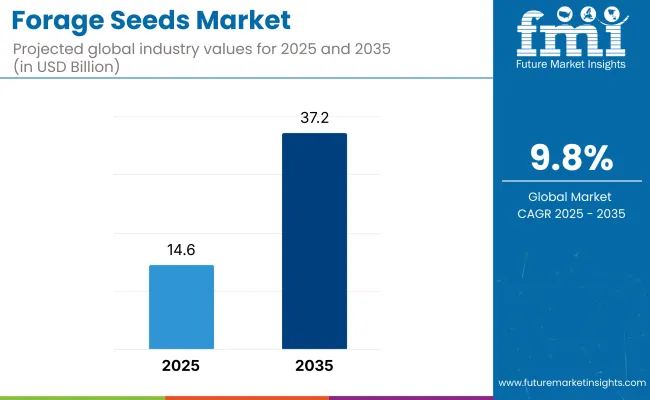
| Attributes | Description |
|---|---|
| Estimated Global Forage Seeds Business Size (2025E) | USD 14.6 billion |
| Projected Global Forage Seeds Business Value (2035F) | USD 37.2 billion |
| Value-based CAGR (2025 to 2035) | 9.8% |
This strong market growth is being propelled by the increasing demand for high-performance animal feed, especially in regions experiencing rapid expansion in the livestock and dairy industries. The use of forage seeds has been expanding in alignment with agricultural intensification practices, as well as efforts to improve animal nutrition through nutrient-rich, sustainable, and locally adaptable feed sources.
Dominating the market are grasses, which are estimated to account for more than half of global forage seed demand in 2025. Grasses offer superior yield characteristics, adaptability across agro-climatic zones, and compatibility with pasture-based dairy and meat production systems.
This is further supported by policy-backed adoption of sustainable forage systems and enhanced awareness around optimal feed-to-meat conversion rates. Improved forage varieties, including high-digestibility cultivars and pest-resistant hybrids, have contributed to rising productivity and consistent re-sowing practices across both temperate and tropical zones.
The market remains highly influenced by R&D in seed traits, with leading companies expanding their portfolios through agronomic trials, proprietary breeding technologies, and targeted regional rollouts. As demand for silage and hay crops strengthens, especially across North America, Europe, and parts of Asia-Pacific, producers are expected to leverage tailored forage seed blends optimized for regional livestock needs, climatic factors, and harvest cycles. Mechanized sowing and harvesting practices are also accelerating adoption across large-scale commercial farms, reinforcing the importance of high-quality seed inputs.
Strategically, the forage seed industry is undergoing consolidation with partnerships and licensing agreements becoming central to market expansion and distribution efficiencies. In 2023, the USDA also highlighted forage crop resilience as critical to national feed security, reinforcing public–private initiatives to strengthen breeding programs.
Furthermore, Corteva Agriscience noted in a 2024 media release that its forage segment "continues to experience double-digit growth, driven by customer demand for climate-smart feed solutions." Going forward, the sector is expected to see heightened investment in seed treatment technologies and digital platforms for crop advisory, ensuring greater on-farm effectiveness and traceability from seed to silo.
The below table presents a comparative assessment of the variation in CAGR over six months for the base year (2024) and the current year (2025) for the global forage seeds market. This analysis highlights key shifts in performance and provides insights into revenue realization patterns, allowing stakeholders to understand the market’s growth trajectory.
The first half of the year (H1) spans from January to June, while the second half (H2) includes the months from July to December. In the first half of the decade (2024 to 2034), the market is projected to grow at a CAGR of 9.4%, followed by an acceleration to 9.9% in the second half of the same decade.
Moving into the subsequent period (H1 2025 to H2 2035), the CAGR is expected to rise to 9.5% in H1 and sustain robust growth at 10.0% in H2. In H1 2025, the industry witnessed an increase of 30 BPS, while in H2 2025, it observed a decrease of 20 BPS.
Semi-annual Market Update
| Particular | H1 |
|---|---|
| Year | 2024 to 2034 |
| Value CAGR | 9.4% |
| Particular | H2 |
|---|---|
| Year | 2024 to 2034 |
| Value CAGR | 9.9% |
| Particular | H1 |
|---|---|
| Year | 2025 to 2035 |
| Value CAGR | 9.5% |
| Particular | H2 |
|---|---|
| Year | 2025 to 2035 |
| Value CAGR | 10.0% |
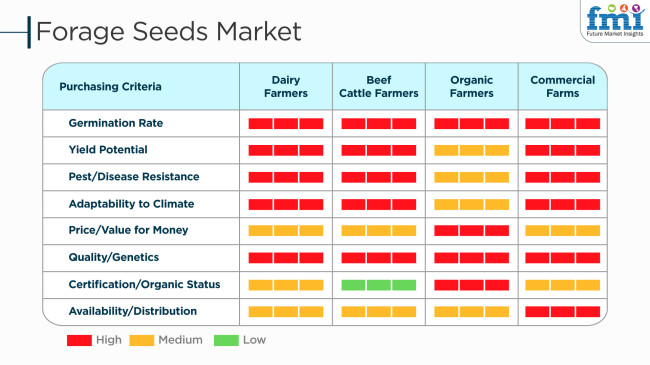
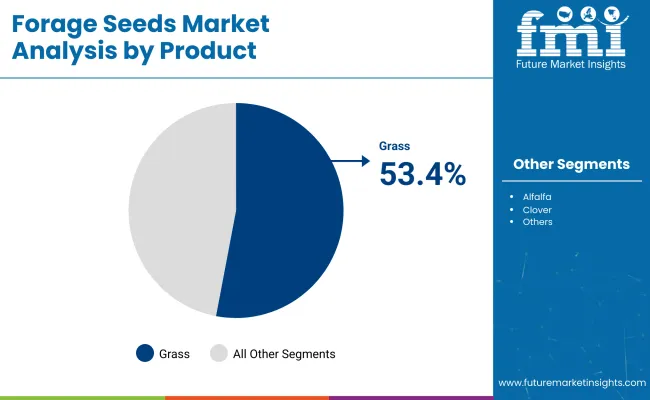
Grasses accounted for an estimated 53.4% share of the global forage seeds market in 2025 and are projected to expand at a CAGR of 8.9% through 2035.
The grasses segment is expected to remain the strategic backbone of the forage seeds market over the forecast period, driven by its superior agronomic performance, environmental adaptability, and cost-efficiency in supporting livestock productivity. In particular, grasses offer multi-seasonal applicability, higher biomass output, and compatibility with sustainable rotational grazing systems, making them an indispensable component in both intensive and pasture-based feeding regimes.
Adoption has been reinforced by institutional support for climate-resilient fodder systems, particularly in developed markets where regulatory frameworks increasingly favor regenerative agricultural practices. In developing regions, the grasses segment is being further catalyzed by the need to close productivity gaps in ruminant farming through nutrient-dense feed resources.
Competitive advantages are expected to persist, as R&D pipelines continue to deliver improved cultivars that meet performance benchmarks for drought tolerance, digestibility, and regrowth potential. With silage and hay systems becoming more mechanized and commercially viable, seed suppliers in this segment are also advancing precision agriculture tools to optimize sowing density, nutrient use, and forage preservation outcomes. As a result, grasses are not only projected to dominate in volume terms but also play a pivotal role in elevating feed conversion efficiency across global livestock production landscapes.
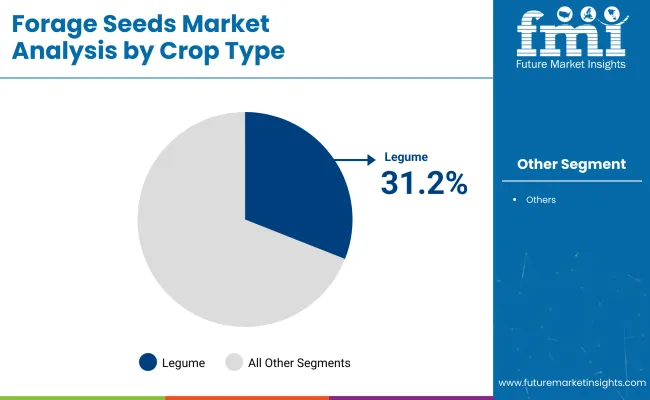
Legumes are anticipated to capture a 31.2% share of the global forage seeds market by 2035, growing at a CAGR of 10.5% over the forecast period.
Legume-based forage seeds are poised to gain significant traction as the livestock sector intensifies its focus on feed quality, environmental performance, and soil health. Known for their high protein content and nitrogen-fixing capabilities, forage legumes have emerged as essential components in mixed swards and silvopasture systems.
The segment’s expansion is being underpinned by the increasing adoption of integrated crop–livestock systems and efforts to reduce reliance on synthetic inputs. In advanced economies, demand is being further bolstered by dairy and beef producers seeking to enhance milk yields and weight gain without escalating feed costs. Meanwhile, in emerging markets, legumes are increasingly seen as enablers of smallholder resilience and pasture regeneration. Industry stakeholders are investing in varietal improvements focused on disease resistance, persistence under grazing pressure, and compatibility with diversified cropping cycles.
Although market penetration currently trails grasses, the long-term opportunity for legumes is considerable, especially as carbon-conscious and biodiversity-focused practices take hold. With a strategic role in boosting on-farm protein availability and reducing greenhouse gas emissions associated with conventional feed production, legume forage seeds are set to transition from supplemental to foundational status in the global forage strategy portfolio.
Producers of forage seeds face substantial environmental and regulatory challenges that impact both yield and expansion. Climate change adds uncertainty to the seed production process: erratic weather - from extended droughts to sudden floods - threatens to dramatically reduce the yield and quality of crops.
Although, this environmental uncertainty makes it harder for producers to have a stable supply. R&D investment of thousands of man-hours go into breeding higher-yielding, pest-resistant forage varieties, as the cost of innovation makes it skilfully prohibitive with a high barrier to entry for new products.
The industry is also complicated further by various and uneven certification regulations surrounding genetically modified or hybrid seeds, which are applied differently across territories. Navigating these complex and often strict regulations can lead to problems with getting a product approved and/or limits on which industries a product can be sold in.
Thus, forage seed companies are forced to either grow their investments on research or achieve compliance with a wide range of regulatory requirements, opening up a natural industry expansion process that is difficult at best in an industry-with intense pressure from climate variability and high development costs.
Varying prices according to perceived performance advantages and intended final product is a common approach that forage seed retailers take. Status-based premium pricing is prevalent in the context of advanced hybrid or genetics modified seed that exhibit superior traits like increased yield, better disease resistance, or higher drought tolerance.
Farmers are usually predisposed to paying a higher cost for seeds that significantly enhance pasture output or livestock health. Moreover, the pricing is also tiered according to the specific segment of livestock; a specific seed mix for dairy cattle, for example, might be priced higher than more generic blends for general grazing purposes.
Seed companies may offer bulk discounts and volume-based pricing to appeal to large-scale enterprises, such as commercial ranches or cooperative farms, taking advantage of economies of scale to lower the per-unit cost. This multi-tiered pricing strategy allows producers to capture revenue from a broader spectrum of customers, catering to both premium segments and cost-conscious consumers.
The global forage seeds industry exhibits a moderately concentrated structure, dominated by multinational corporations (MNCs), regional players, and local seed producers.
Multinational Corporations (MNCs)
Large MNCs hold a significant share of the industry, leveraging advanced seed technology, genetic modification, and research-driven breeding programs to enhance productivity. These companies focus on global expansion, strategic collaborations, and mergers to strengthen their foothold. Increasing investment in sustainable and climate-resilient forage seeds is a key growth driver.
Additionally, MNCs are expanding their production capacities in key agricultural regions to cater to the rising demand for high-yield, disease-resistant, and drought-tolerant forage seeds.
Regional Players
Regional manufacturers focus on customized forage solutions tailored to local climatic conditions and soil types. They emphasize affordable seed varieties, non-GMO options, and organic offerings to attract sustainability-conscious consumers.
Many regional players are forming public-private partnerships to improve seed distribution and accessibility. The rising demand for chemical-free, natural livestock feed is further propelling the expansion of regional players in developed and emerging economies.
Local Seed Producers
Local producers cater to small-scale farmers and niche industries, offering cost-effective and indigenous forage seed varieties. They play a vital role in preserving traditional seed varieties and meeting specific demands for organic and regenerative farming practices. As consumer preference shifts toward natural and traceable feed sources, local seed suppliers are capitalizing on direct farmer engagement and digital distribution models.
With increasing competition, MNCs, regional players, and local producers are adopting innovative strategies, technological advancements, and sustainability-focused initiatives to strengthen their positions globally.
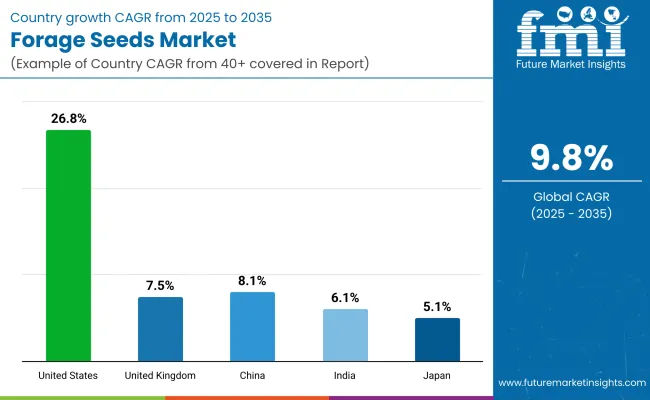
| Countries | Value (2035) |
|---|---|
| United States | 26.8% |
| United Kingdom | 7.5% |
| China | 8.1% |
| India | 6.1% |
| Japan | 5.1% |
FMI projects the United States to be the largest and fastest-growing industry for forage seeds, with an impressive CAGR of 26.8% during 2025 to 2035. Its large number of dairy and beef cattle drives the demand for high-yielding forage crops like alfalfa, clover, and ryegrass. According to the USA Department of Agriculture (USDA), the nation had 94.8 million head of cattle in 2023, and forage seeds have a crucial role in maintaining productivity among livestock.
Improvement in precision farming, biotechnological advancements, and hybrid seed technologies are driving the use of genetically enhanced forage seeds that have higher yields and resistance to pest and environmental stresses. Private industry and USDA R&D projects, like those undertaken by Monsanto and Corteva Agriscience, are actively working on creating drought-resistant and pest-resistant seeds.
In addition to this, research grants and farm subsidies by the government motivate producers to invest in improving forage crops, with a special motivation by the Environmental Quality Incentives Program (EQIP), promoting sustainable grazing land management. Expansion in organic livestock production trends is pushing demand for forage seeds with no chemicals or GMOs as consumers increasingly show demand for dairy and meat with grass-fed features.
Growth Drivers in the USA
| Key Drivers | Details |
|---|---|
| Such a large stock of cattle | 94.8 million cattle (USDA, 2023) demands high-grade forage. |
| Biotechnology innovation | Firms such as Monsanto and Corteva working on drought-resistant seeds. |
| Government assistance | EQIP and other USDA programs fund sustainable forage production. |
| Organic farming trends in agriculture | Growing demand for non-GMO and organic forage seeds used in grass-fed meat and milk. |
| Sustainability efforts | Regenerative farming and improving soil health in the limelight. |
According to FMI, the industry is expected to register 8.1% CAGR during the forecast period. China is witnessing increasing demand for quality forage seeds, mainly because of the growth of dairy and animal husbandry activities.
China's dairy industry has been growing extremely rapidly, and milk production is at 38 million metric tons in 2023. The government's modernization plans to promote large-scale forage cultivation are propelling it, especially in Inner Mongolia and Heilongjiang, where dairy farming is growing.
China's strong dependence on imported alfalfa (primarily from the United States and Canada) has encouraged greater investment in native seed breeding programs as a means of gaining independence. China imported well over 1.5 million metric tons of alfalfa in 2022, and this will further encourage domestic alternatives. Growing demand for high-protein dairy and meat products is propelling the production of high-nutrient forage crops like alfalfa, ryegrass, and clover to improve livestock welfare.
China is also embracing precision farming and hydroponic fodder production to enhance feed efficiency and reduce environmental pressures. For instance, vertical farming methods are under research to cultivate fodder in compact areas.
Growth Drivers in the China
| Key Drivers | Details |
|---|---|
| Dairy industry growth | Milk production amounted to 38 million metric tons in 2023. |
| Reliance on forage imports | Over 1.5 million metric tons of alfalfa imported in 2022. |
| Government modernization efforts | Investments in Inner Mongolia and Heilongjiang for large-scale forage cultivation. |
| Precision agriculture | Increased adoption of hydroponics and vertical farming to enhance feed efficiency. |
| High-protein livestock demand | Increased meat and dairy consumption calling for nutrient-rich forage crops. |
The UK forage seed industry is likely to expand with a CAGR of 7.5% due to expanding use of sustainable rearing of livestock and organic production of fodder. Grass-milk dairy products and meat products have witnessed surging demand, with customers opting for pasture-reared animals over those raised on grain.
Government initiatives like the Environmental Land Management Scheme (ELMS) are promoting low chemical farming and regenerative farming. The farmers are now more often using greater numbers of non-GMO and organic feed seeds to reach sustainability objectives. Climate change is also among the top priorities, which has caused an increase in drought-resistant and cold-resistant varieties of seeds.
The UK agricultural industry is experiencing a technological revolution, with precision agriculture methods, AI-optimized seed selection, and automated irrigation systems increasing efficiency in forage production. For instance, satellite images are being employed to track soil health and improve grazing patterns
Growth Drivers in the UK
| Key Drivers | Details |
|---|---|
| Consumer demand for grass-fed meat/dairy | Upward trend in demand for pasture-raised animals. |
| Regenerative agriculture policy | ELMS supports sustainability and decreased use of chemicals. |
| Climate change adaptation | Deployment of drought and cold-tolerant seeds. |
| Tech farm | AI, satellite imagery, and robot irrigation optimizing yield. |
| Green organic farm co-ops | Mutual support in rotational grazing and land stewardship. |
The forage seed industry of India is increasing at a decent pace due to its big and increasing dairy and livestock industry. Being one of the world's largest milk producers, India needs quality forage to boost more milk production at high rates. There are marginal and small farmers in India, and thus the questions of usability and affordability of forage seeds arise.
Development of fodder is encouraged by the government proactively with schemes such as the National Livestock Mission (NLM) that offers financial support and subsidies for seed distribution of fodder and grazing land development. Drought and high-growth types such as hybrid napier grass, alfalfa, and sorghum are used extensively for productivity improvement.
Climate fluctuation in various parts of the world has resulted in the cultivation of tropical and temperate forage crops. In addition, the growing use of mechanization in fodder production is cutting down wastage and improving efficiency.
Growth Drivers in the India
| Key Drivers | Details |
|---|---|
| Dairy industry growth | India is the largest milk-producing country in the world. |
| Government subsidy | NLM offers financial support for fodder production. |
| Smallholder farmer need | Affordable and durable forage seeds required. |
| Climate resilience | Forage crops, tropical and temperate, are extensively cultivated. |
| Mechanization of fodder cultivation | Improved productivity and minimized wastage. |
Japan's forage seed industry is stimulated mainly by its highly developed livestock and dairy industries, which are the priority customers in buying quality feeds for maximum animal productivity. Cultivation land is extremely scarce in Japan, and thus it depends largely on imports of feed grains, and therefore forage seed technology is extremely important for domestic production.
The nation gives preference to high-yielding and nutritious varieties of forages like timothy grass, alfalfa, and clover in order to have good cattle feeding. Forage crops resistant to climate and digestible in large quantities have become a result of research in the field of agriculture that has increased feeding efficiency.
Growth Drivers in the Japan
| Key Drivers | Details |
|---|---|
| Scarce arable lands | Heavy reliance on foreign feed crops. |
| Dairy and livestock sector | Focus on high-nutrient, high-quality forage crops. |
| Climate-resilient seed innovation | Development of high-digestibility forage crops. |
| Government policies | Promotion of local fodder production to reduce imports. |
| Sustainable agriculture | Organic and non-GMO forage seed promotion. |
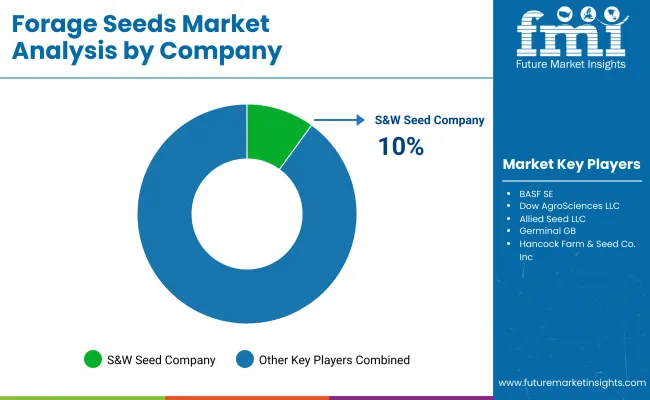
S&W Seed Company (10-14%)
A leading player in the forage seed industry, specializing in alfalfa, sorghum, and pasture seeds with advanced breeding techniques.
BASF SE (8-12%)
BASF is a major contributor to agricultural biotechnology, offering high-yield and pest-resistant forage seed varieties.
Dow AgroSciences LLC (7-11%)
Focuses on developing forage seeds with enhanced nutritional profiles to improve livestock health and productivity.
Allied Seed LLC (6-10%)
Known for its broad portfolio of forage and cover crop seeds, supporting sustainable farming practices.
Germinal GB (5-9%)
A key supplier of high-performance pasture seeds, contributing to the dairy and livestock industries.
Other Key Players (45-55% Combined)
The global Crope type is, Legume, Grass and Others
The global forage seeds market is segmented into Alfalfa, Clover, Ryegrass, Chicory, and Others.
The market is categorized into Poultry, Cattle, Pork/Swine, and Others, with varying forage seed preferences based on dietary needs and feed efficiency requirements.
The forage seeds market spans North America, Latin America, Europe, East Asia, South Asia, Oceania, and the Middle East & Africa.
The market is projected to expand at a CAGR of 9.8% from 2025 to 2035.
By 2035, the market is expected to reach approximately USD 37.2 billion.
The Alfalfa segment is expected to witness the fastest growth due to its high protein content, nitrogen-fixing benefits, and widespread adoption in dairy and beef cattle feed.
Key growth drivers include rising demand for high-protein animal feed, expansion of organic and non-GMO livestock farming, increasing dairy and meat consumption, and advancements in drought-resistant and high-yield forage seed varieties.
Leading companies in the forage seeds market include DLF Seeds A/S, S&W Seed Company, Allied Seed LLC, Barenbrug Group, BrettYoung, and Growmark Inc., known for their innovation, regional expansions, and sustainable seed breeding initiatives.






Our Research Products

The "Full Research Suite" delivers actionable market intel, deep dives on markets or technologies, so clients act faster, cut risk, and unlock growth.

The Leaderboard benchmarks and ranks top vendors, classifying them as Established Leaders, Leading Challengers, or Disruptors & Challengers.

Locates where complements amplify value and substitutes erode it, forecasting net impact by horizon

We deliver granular, decision-grade intel: market sizing, 5-year forecasts, pricing, adoption, usage, revenue, and operational KPIs—plus competitor tracking, regulation, and value chains—across 60 countries broadly.

Spot the shifts before they hit your P&L. We track inflection points, adoption curves, pricing moves, and ecosystem plays to show where demand is heading, why it is changing, and what to do next across high-growth markets and disruptive tech

Real-time reads of user behavior. We track shifting priorities, perceptions of today’s and next-gen services, and provider experience, then pace how fast tech moves from trial to adoption, blending buyer, consumer, and channel inputs with social signals (#WhySwitch, #UX).

Partner with our analyst team to build a custom report designed around your business priorities. From analysing market trends to assessing competitors or crafting bespoke datasets, we tailor insights to your needs.
Supplier Intelligence
Discovery & Profiling
Capacity & Footprint
Performance & Risk
Compliance & Governance
Commercial Readiness
Who Supplies Whom
Scorecards & Shortlists
Playbooks & Docs
Category Intelligence
Definition & Scope
Demand & Use Cases
Cost Drivers
Market Structure
Supply Chain Map
Trade & Policy
Operating Norms
Deliverables
Buyer Intelligence
Account Basics
Spend & Scope
Procurement Model
Vendor Requirements
Terms & Policies
Entry Strategy
Pain Points & Triggers
Outputs
Pricing Analysis
Benchmarks
Trends
Should-Cost
Indexation
Landed Cost
Commercial Terms
Deliverables
Brand Analysis
Positioning & Value Prop
Share & Presence
Customer Evidence
Go-to-Market
Digital & Reputation
Compliance & Trust
KPIs & Gaps
Outputs
Full Research Suite comprises of:
Market outlook & trends analysis
Interviews & case studies
Strategic recommendations
Vendor profiles & capabilities analysis
5-year forecasts
8 regions and 60+ country-level data splits
Market segment data splits
12 months of continuous data updates
DELIVERED AS:
PDF EXCEL ONLINE
Forage Market Analysis by Crop Type, Forage Type, Target, and Animal Type Through 2035
Forage Inoculants Market
Haying and Forage Equipment Market Size and Share Forecast Outlook 2025 to 2035
Flaxseeds Market – Growth, Demand & Nutritional Benefits
Citrus Seeds Market Size and Share Forecast Outlook 2025 to 2035
Hybrid Seeds Market Size and Share Forecast Outlook 2025 to 2035
Industry Share Analysis for Sesame Seeds Companies
Caraway Seeds Market
Americas Seeds Market Size and Share Forecast Outlook 2025 to 2035
Chamomile Seeds Market – Growth & Demand 2025 to 2035
Hybrid Rice Seeds Market Size and Share Forecast Outlook 2025 to 2035
Packaged Sunflower Seeds Market – Growth, Demand & Consumer Trends
Rubus Idaeus (Raspberry) Seeds Market

Thank you!
You will receive an email from our Business Development Manager. Please be sure to check your SPAM/JUNK folder too.
Chat With
MaRIA